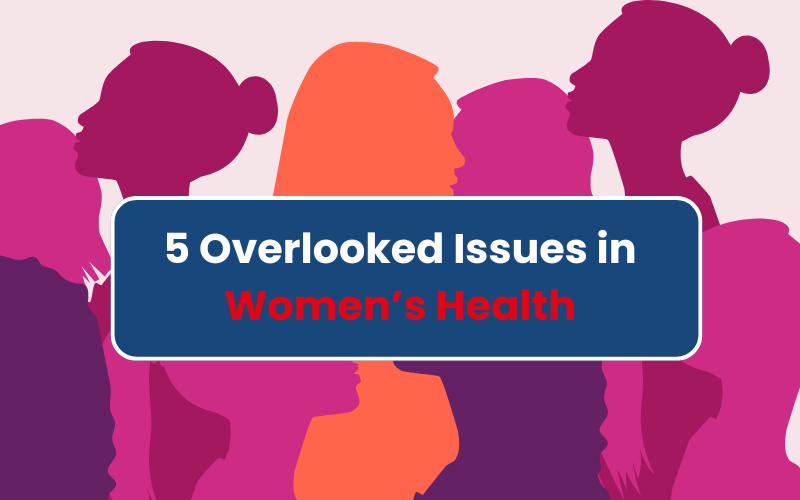Women’s health is a complex and multifaceted topic that encompasses various physical, emotional, and mental aspects. Despite the importance of women’s health, many issues remain overlooked or undiagnosed.
Why Women’s Health is Often Overlooked
Women’s health is often overlooked due to a combination of societal, cultural, and historical factors. Some of the reasons include:
- Historical Bias in Medical Research- Historically, medical research has been conducted primarily on men, with women’s health issues often being neglected or understudied. This has led to a lack of understanding and awareness about women’s health issues.
- Stigma and Taboos- There is often a stigma surrounding women’s health issues, particularly those related to reproductive health and mental health. This can make it difficult for women to discuss their health concerns openly and seek medical attention.
- Normalization of Symptoms- Women’s health symptoms are often normalised or dismissed as “normal” or “hormonal.” This can lead to delayed diagnosis and treatment of underlying health issues.
- Limited Access to Healthcare- Women in low-income communities or with limited access to healthcare may face barriers in seeking medical attention and receiving proper care.
Overlooked health issues
Let’s explore 5 overlooked women’s health issues and how being informed can empower women to take control of their well-being.
- Polycystic Ovary Syndrome (PCOS)
Polycystic Ovary Syndrome (PCOS) impacts 8-13% of women of reproductive age, yet it often goes undiagnosed and misunderstood. This hormonal disorder can cause a range of symptoms, including irregular periods, excessive hair growth, acne, and weight gain. Beyond physical symptoms, PCOS can also have a profound impact on mental health, increasing the risk of depression and anxiety.
The varied and often unpredictable symptoms of PCOS can lead to misdiagnosis or dismissal. Societal stigma surrounding menstrual health and body image issues can also prevent open discussions, further delaying diagnosis and treatment. As a result, many women struggle with PCOS without receiving the care and support they need.
- Endometriosis
Endometriosis affects an estimated 1 in 10 women of reproductive age, yet it remains poorly understood and often undiagnosed. This chronic condition occurs when tissue similar to the lining of the uterus grows outside the uterus, leading to severe pain, heavy bleeding, and infertility. Beyond physical symptoms, endometriosis can also have a significant impact on mental health and quality of life.
The symptoms of endometriosis can be diverse and unpredictable, often leading to delayed diagnosis. Normalization of menstrual pain and stigma surrounding women’s health issues can prevent open discussions, making it difficult for women to seek medical attention and receive proper care. As a result, many women suffer in silence, struggling to manage their symptoms and find effective treatment.
- Thyroid Disorders
Thyroid disease affects millions of people worldwide, yet it often goes undiagnosed or misdiagnosed. Both hypothyroidism (underactive thyroid) and hyperthyroidism (overactive thyroid) can cause a range of symptoms, including fatigue, weight changes, mood swings, and hair loss. If left untreated, thyroid disease can have significant consequences on overall health and well-being.
The symptoms of thyroid disease can be subtle and nonspecific, making it challenging to diagnose. Additionally, thyroid disease often masquerades as other conditions, leading to delayed diagnosis and treatment. Furthermore, lack of awareness and inadequate testing can prevent individuals from receiving proper care, emphasizing the need for increased awareness and education about thyroid health.
- Osteoporosis
Osteoporosis is a major health concern for women, particularly after menopause. The hormonal changes that occur during menopause can lead to a rapid decline in bone density, increasing the risk of osteoporosis. Women are more likely to experience fractures and osteoporotic compression fractures, which can significantly impact quality of life.
Osteoporosis is often referred to as a “silent disease” because bone loss can occur without symptoms until a fracture occurs. Women may not prioritise bone health or may not be aware of their risk factors, leading to delayed diagnosis and treatment. Additionally, lack of awareness and inadequate screening can prevent women from taking proactive steps to protect their bone health, emphasizing the need for education and awareness about osteoporosis prevention and treatment.
- Cardiovascular Disease
Despite common perceptions, cardiovascular disease (CVD) is a leading cause of death among women worldwide. Women often experience distinct symptoms, including shortness of breath, nausea, and back or jaw pain, which can lead to delayed or incorrect diagnoses.
Historically, medical research and diagnosis have been biased towards male-dominated studies, resulting in a lack of representation of women in CVD research. This disparity has contributed to limited awareness about the unique symptoms and risk factors that affect women, ultimately impacting timely and effective treatment.
Awareness & Knowledge
Being informed about women’s health issues can empower women to take control of their well-being. By understanding the signs and symptoms of various conditions, women can seek medical attention and manage their health effectively. Knowledge is power, and in the context of women’s health, it’s essential for maintaining overall well-being.



